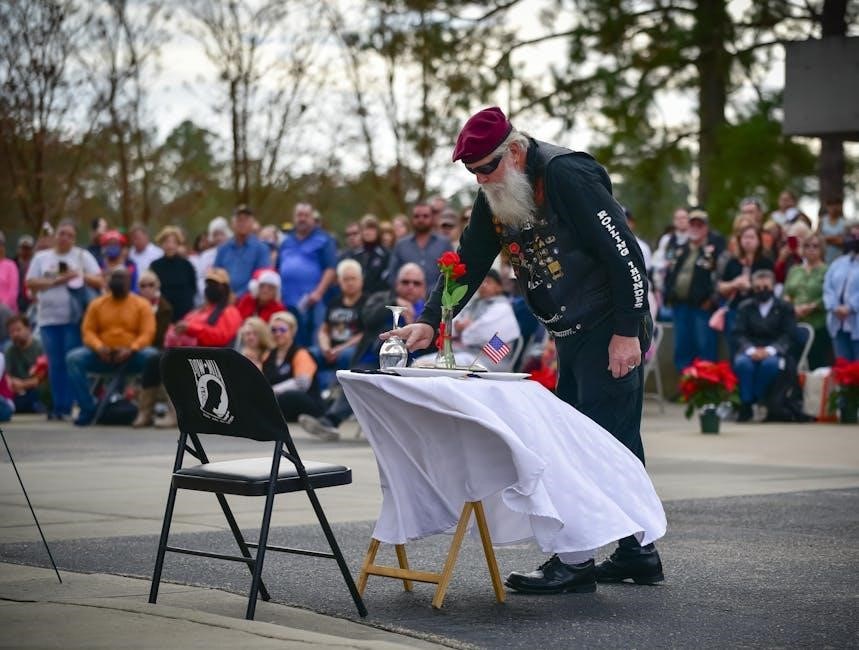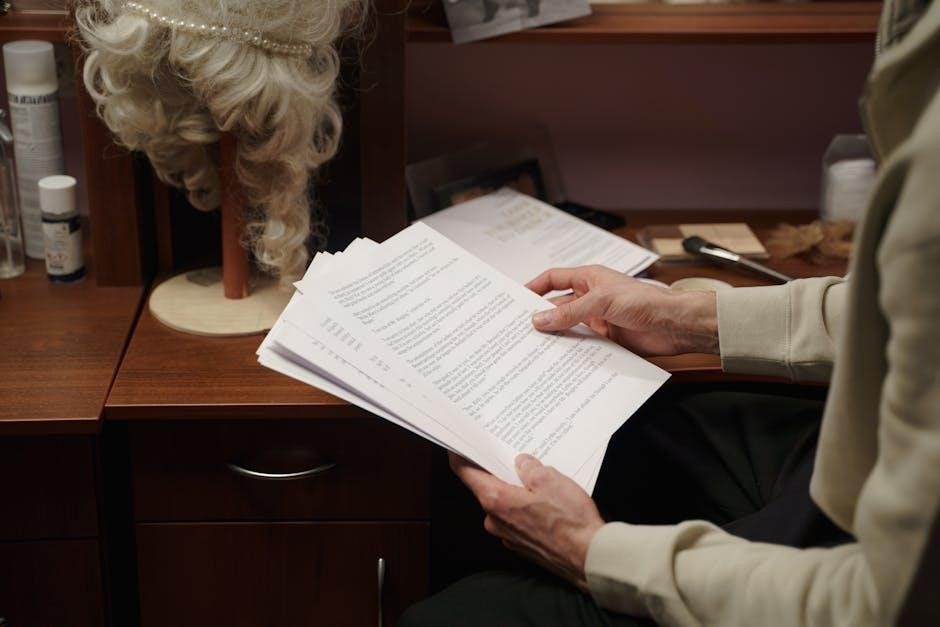The Missing Man Table is a solemn ceremony honoring fallen, missing, or imprisoned service members, symbolizing their enduring presence in our collective memory․ The table is set for one, symbolizing the absence of those who have not returned home, serving as a poignant reminder of their sacrifice․

1․1․ Overview of the Missing Man Table Ceremony
The Missing Man Table Ceremony is a solemn tradition honoring fallen, missing, or imprisoned service members․ The table is set for one, symbolizing the absence of those who have not returned home․ It serves as a poignant reminder of their sacrifice and enduring presence in our collective memory․ The ceremony typically includes a narrator explaining the symbolism of each item on the table, such as the round table representing everlasting concern, the white tablecloth for purity, and the single rose for loved ones․ This ritual is often a focal point at events like Memorial Day ceremonies or military reunions․
1․2․ Purpose of the Ceremony
The purpose of the Missing Man Table Ceremony is to honor fallen, missing, or imprisoned service members, ensuring their memory and sacrifices are never forgotten․ It serves as a poignant reminder of their enduring presence in the hearts of their comrades and the nation․ The ceremony also aims to comfort the families of the missing by acknowledging their loss and keeping the memory of their loved ones alive․ Additionally, it raises awareness about the plight of POW/MIA service members, emphasizing the importance of their contributions and the need for continued support and advocacy․
1․3․ Historical Background
The Missing Man Table tradition originated in the U․S․ military, particularly among aviation units, as a way to honor fallen comrades․ It gained prominence during the Vietnam War, symbolizing the bond between service members and the nation’s commitment to remembering those who never returned․ The ceremony formalized over time, becoming a poignant ritual at military gatherings and veterans’ events․ Its roots reflect the camaraderie and respect shared among those who serve, ensuring the sacrifices of missing and imprisoned service members are never forgotten․ This tradition has since become a powerful symbol of remembrance and unity across military communities worldwide․

Symbolism of the Missing Man Table
The Missing Man Table is rich in symbols: a round table for everlasting concern, a white cloth for purity, a rose for families, a candle for remembrance, and an empty chair for absence, collectively honoring fallen and missing service members․
2․1․ The Round Table
The round table is a central element, symbolizing the everlasting concern for missing service members․ Its shape, lacking edges or corners, represents unity and the continuous nature of remembrance․ It signifies that the absence of loved ones is never forgotten, embodying the community’s enduring support and commitment to their memory․
2․2․ The White Tablecloth
The white tablecloth symbolizes the purity of intention and the noble motives of those who answered their nation’s call to service․ Its pristine condition represents the untarnished ideals and integrity of the missing individuals, serving as a visual reminder of their selflessness and the sanctity of their sacrifice․
2․3․ The Single Rose
The single rose placed on the table symbolizes the love, remembrance, and enduring bond with those who are missing․ It honors the life of each absent service member and their families, serving as a poignant reminder of their presence in our hearts․ The rose also embodies hope and faith, reflecting the cherished belief that one day, the missing will return home․ Its beauty and fragrance underscore the emotional connection we maintain with those who have not yet been found, ensuring their memory lives on in our collective consciousness․
2․4․ The Burning Candle
The burning candle is a powerful symbol of hope and light in the darkness․ It represents the enduring spirit of those who are missing and the unwavering belief in their eventual return․ The flame serves as a beacon, reminding us of the sacrifices made and the unity we share in honoring their memory․ It also signifies the light of freedom and the guiding hope that illuminates the path for those who have not yet come home․ The candle’s steady glow embodies the resilience and faith of the families and comrades of the missing, ensuring their presence is never forgotten․
2․5․ The Empty Chair
The empty chair at the Missing Man Table holds profound significance, symbolizing the absence of those who are missing or have made the ultimate sacrifice․ It serves as a poignant reminder of the void left by their departure and the deep longing for their return․ The chair remains untouched and unoccupied, honoring the memory of the fallen and missing service members․ Its emptiness is a powerful visual representation of their absence, evoking emotions of respect, gratitude, and remembrance among all who witness it․ The empty chair ensures that their presence is acknowledged and their legacy lives on in our hearts․
2․6․ The Table Setting for One
The table setting for one emphasizes the isolation and loneliness felt without the missing service members․ A single plate, fork, knife, and glass symbolize the individuality of each missing person, while the absence of utensils for others underscores their absence․ This arrangement highlights the solemnity of the occasion, ensuring their memory is honored and their sacrifice remembered․ The simplicity of the setting amplifies the emotional impact, serving as a constant reminder of those who remain unaccounted for․ The table for one is a heartfelt tribute, symbolizing the enduring bond with the missing and the hope for their eventual return․

The Missing Man Table Ceremony Script
The Missing Man Table Ceremony Script is a solemn tribute honoring fallen, missing, or imprisoned service members․ It includes opening narration, symbol explanations, and closing remarks, ensuring dignity and respect for the absent․
3․1․ Opening Narration
The opening narration sets the tone for the ceremony, inviting silence and reflection․ It acknowledges the special table honoring missing or imprisoned service members, emphasizing their enduring presence in our collective memory․ The narrator explains the table’s symbolic setup, drawing attention to its significance and the solemnity of the occasion․ This moment is crucial for establishing the ceremony’s purpose and fostering a sense of unity among attendees․ The narration is delivered with dignity, ensuring respect for those being honored and their families․
3․2․ Explanation of Each Symbol
The round table symbolizes everlasting concern for missing service members, representing unity and continuity․ The white tablecloth embodies purity of intent and loyalty to duty․ A single red rose honors the missing and their families, while the burning candle signifies hope and remembrance․ The empty chair stands as a poignant reminder of absence, and the table setting for one highlights the isolation of those missing․ Each symbol is carefully chosen to evoke deep reflection and respect for the sacrifices made․ Together, they create a powerful visual narrative of honor and longing․
3․3․ Closing Remarks
In closing, we honor the memory of those who remain absent yet forever present in our hearts․ The Missing Man Table serves as a powerful reminder of their sacrifices and our enduring commitment to their legacy․ Let us continue to remember, honor, and support those who have not returned, as well as their families; May this ceremony inspire us to uphold the values of courage, loyalty, and resilience that define our service members․ Together, we pledge to never forget and to strive for the safe return of all those still missing․ Their memory lives on in our collective spirit․
3․4․ Printable PDF Version

A printable PDF version of the Missing Man Table ceremony script is available for convenient use at events, ensuring a respectful and organized presentation․ This version includes the full script, explanations of symbols, and instructions for setup․ It is ideal for Memorial Day ceremonies, military gatherings, or veteran reunions․ The PDF format allows for easy sharing and preparation, ensuring all participants can review their roles beforehand․ By downloading the PDF, organizers can efficiently plan and execute the ceremony, maintaining the tradition’s dignity and emotional impact․ This resource is a valuable tool for honoring fallen, missing, or imprisoned service members․

Preparation for the Ceremony
Preparation involves setting the table with symbolic elements, selecting a narrator, and rehearsing the script to ensure a respectful and meaningful tribute to honor missing service members․
4․1․ Setting Up the Table
Setting up the Missing Man Table requires meticulous attention to detail․ The table is typically round, symbolizing everlasting concern for missing service members․ A white tablecloth represents purity of intent, while a single red rose honors their loved ones․ A burning candle signifies the light of hope, and an empty chair reminds us of their absence․ The table is set for one, with a plate, utensils, and a glass, yet remains untouched, symbolizing the isolation of those missing․ Each element holds profound significance, ensuring the ceremony conveys respect and remembrance for those who have not returned home․
4․2․ Choosing the Narrator
Choosing the narrator for the Missing Man Table ceremony is a critical decision, as the narrator must convey the solemnity and gravity of the event․ The narrator should possess a strong, clear voice and the ability to deliver the script with dignity and emotional resonance․ Ideally, the narrator is someone with a personal connection to the cause, such as a veteran or a family member of a service member․ They must be comfortable with public speaking and able to maintain composure during the ceremony; The narrator’s role is to guide the audience through the symbolism and significance of the table, ensuring the ceremony’s message is delivered respectfully and effectively․
4․3․ Rehearsing the Script
Rehearsing the script for the Missing Man Table ceremony is essential to ensure a dignified and respectful presentation․ The narrator should practice delivering the words with clarity and emotion, maintaining a steady pace to convey the gravity of the occasion․ It is important to rehearse in the actual venue to familiarize oneself with the setting and timing․ The script should be reviewed multiple times to ensure accuracy and confidence․ Rehearsal also helps in coordinating the ceremony’s flow, including the placement of items on the table and the participation of others involved․ Proper preparation ensures the ceremony honors the missing service members appropriately․

Execution of the Ceremony
The ceremony is conducted with dignity, ensuring all elements align with tradition․ The narrator delivers the script solemnly, while attendees observe moments of silence and respect․ The table remains a focal point, symbolizing the absence of missing service members and honoring their memory through thoughtful rituals and reflections․
5․1․ Timing and Venue
The Missing Man Table Ceremony is typically conducted during formal events such as Memorial Day, military reunions, or veteran gatherings․ The venue should be chosen to ensure visibility and reverence, often placed at the entrance or front of the room․ Timing is crucial, with the ceremony usually occurring at the beginning or end of the event to maximize its emotional impact․ The setting should foster a solemn atmosphere, allowing attendees to reflect on the significance of the table and honor the absent service members appropriately․
5․2․ Audience Participation
Audience participation is crucial in the Missing Man Table Ceremony, fostering a shared moment of remembrance․ Upon the narrator’s direction, attendees are often invited to stand and direct their attention to the table․ A moment of silence is typically observed, allowing individuals to reflect on the sacrifices of the absent service members․ The audience’s respectful engagement underscores the ceremony’s solemnity, creating a collective acknowledgment of the missing and their enduring legacy․ This shared experience strengthens the emotional connection and ensures the ceremony’s meaningfulness for all present․
5․3․ Handling Special Requests

Special requests during the Missing Man Table Ceremony are handled with care to maintain the ceremony’s dignity․ Requests may include personal items or specific readings․ A designated committee or organizer reviews these requests to ensure they align with the ceremony’s purpose․ If approved, the narrator incorporates the request seamlessly, preserving the solemn atmosphere․ The focus remains on honoring the missing service members, ensuring all additions enhance, rather than distract from, the ceremony’s intent․ This approach balances respect for individual wishes with the tradition’s integrity, fostering a meaningful experience for all participants․ Proper decorum is maintained throughout to uphold the ceremony’s significance․

Cultural and Emotional Impact

The Missing Man Table Ceremony holds profound cultural and emotional significance, honoring fallen service members and comforting their families․ It raises awareness about POW/MIA issues, fostering unity and reflection․
6․1․ Honoring Fallen Service Members
The Missing Man Table Ceremony is a heartfelt tribute to fallen service members, ensuring their memory endures․ The table’s setup, with a white tablecloth, a single rose, and a burning candle, symbolizes purity, remembrance, and the light guiding them home․ This solemn ritual honors their ultimate sacrifice, offering solace to families and comrades․ It reinforces the commitment to never forget those who gave their lives for freedom, keeping their legacy alive in the hearts of the nation․
6․2․ Comforting Families of the Missing
The Missing Man Table Ceremony offers profound solace to families of the missing, acknowledging their loss and enduring uncertainty․ The single red rose symbolizes the bond between families and their loved ones, while the burning candle represents the light of hope․ This ceremony reassures families that their sacrifices are remembered and honored․ It creates a sense of community and shared remembrance, letting them know they are not alone in their grief․ The table’s presence underscores the nation’s commitment to never forget those who remain unaccounted for, providing emotional support and a lasting tribute to their loved ones․
6․3․ Raising Awareness About POW/MIA Issues
The Missing Man Table Ceremony plays a crucial role in raising awareness about POW/MIA issues, ensuring their stories are not forgotten․ By highlighting the symbolism of the table, the ceremony educates the public about the sacrifices of service members and their families․ It serves as a visual reminder of unresolved cases, prompting discussions and advocacy․ This tradition fosters a collective commitment to seeking answers and supporting efforts to bring home those still missing․ The ceremony’s visibility at public events ensures that POW/MIA issues remain in the national consciousness, inspiring action and solidarity for their cause․
The Missing Man Table ceremony is a poignant tribute to fallen, missing, and imprisoned service members, ensuring their memory endures․ It serves as a commitment to their legacy․
7․1․ Final Thoughts on the Ceremony
The Missing Man Table ceremony is a profound tribute to those who have made the ultimate sacrifice․ It serves as a reminder of the enduring bond between comrades and the nation’s gratitude for their service․ The ceremony’s emotional weight lies in its symbolism, ensuring the memories of the fallen, missing, or imprisoned are never forgotten․ It unites participants in a shared moment of reflection, honoring their legacy and reaffirming the commitment to their families․ The table’s setup, with its meticulous details, underscores the importance of preserving this tradition as a testament to their courage and sacrifice․
7․2․ Importance of Preserving the Tradition
Preserving the Missing Man Table tradition ensures that the sacrifices of fallen, missing, or imprisoned service members are never forgotten․ It serves as a vital link to history, educating future generations about the cost of freedom․ By maintaining this ceremony, we honor the legacy of those who have served, offering comfort to their families and loved ones․ It also fosters a sense of unity and shared purpose among communities, reminding society of the enduring impact of their service․ Upholding this tradition guarantees that their memories remain alive, inspiring gratitude and respect for generations to come․
7․3․ Encouraging Participation and Support
Encouraging participation and support for the Missing Man Table tradition is crucial for preserving its significance․ Communities, organizations, and individuals can contribute by attending ceremonies, sharing the story of the table, and educating others about its meaning․ Schools and youth groups can incorporate the tradition into their programs to ensure its legacy endures․ Supporting families of the missing and advocating for POW/MIA awareness also strengthens the impact of the ceremony․ By fostering a sense of shared responsibility, we can ensure that the sacrifices of service members are remembered and honored for generations to come․
